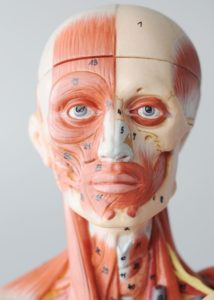Lengthening and Strengthening Your Facial Muscles

When you have a pre consultation with your massage therapist, which muscle groups do you most often voice concern about? If you’re like the majority of patients who come in to see me, it’s the neck, shoulders, and back muscles. Followed in popularity by those muscle groups would be everything from the glutes down to the feet; leaving the arms, hands, and chest largely ignored.
But there’s one particular muscle group that often goes even more neglected than those: the facial muscles. And I’m not just talking about your jaw muscles. The frontalis in your forehead, the temporalis in your temples, the nasalis between your brows, and the orbicularis oculi around your eyes need help too!
So how do we help them?
The Importance of Healthy Facial Muscles
Adhesions in facial muscles are often caused by, or can cause, temporomandibular joint (TMJ) disorder, bruxism, sinus pressure, headaches, and neck pain. In severe cases of impaired facial tissue, mundane actions such as chewing and talking can put considerable strain on the face.
The issues don’t stop there, though. Did you know that facial discomfort can actually work its way all the way down the posterior chain? The reason why the neck muscles tighten in response to facial pain is because the neck and jaw joints connect to each other. When the neck muscles tighten, the shoulder and upper back muscles below will have to overcompensate. When the shoulder and upper back muscles overwork themselves, the lower back and hip muscles will have to pick up the slack for them. This wearing out of muscular tissue can continue down into the legs and feet if corrective treatment is postponed for too long.
So if you experience facial pain or have a history of conditions that affect the facial muscles, seek out body work before a few aches become problematic for the rest of the body.
How Bodywork Lengthens and Strengthens Your Facial Muscles
Facial massage and assisted stretching/exercises have been shown to remove muscular adhesions, which leads to the lengthening of the tight tissue. Lengthened muscles lead to improved mobility, which strengthens the muscles that were weakened by the initially adhesed muscle.
The Best Modalities for Impaired Facial Muscles
- Deep Tissue for Jaw Muscle – Slow, deep, methodical strokes on the masseter will comb through the knotted muscular tissue.
- Pin and Stretch – With pin and stretch techniques, the massage therapist and the patient work together to lengthen muscular tissue while removing adhesions. While the therapist’s fingers are placed on the masseter attachments at the mandible, the patient will slowly open and close the mouth. As the patient elevates and depresses the jaw, the therapist’s fingers will glide up towards the cheek bones. This process will be repeated until the knots release.
- Lymphatic Drainage – This technique is best for sinus pressure. Lymphatic drainage massage uses light touch to guide lymph toward the lymph nodes located along the jaw and neck.
- Trigger Point Therapy – You can have trigger points anywhere in the body, but the points in the forehead, temples, orbicularis oculi, and nasalis often go neglected.
- Intraoral Massage – This type of massage, while a bit invasive, allows the massage therapist to relieve trigger points and tight tissue from inside the mouth.
- Swedish Massage – While often deemed a relaxation massage as opposed to a medical massage, the glides and kneading of Swedish massage do more than just relax a stressed mood. Therapeutic touch in general gets the blood flowing, and that nutrient-rich blood feeds oxygen to the affected facial muscles. Nourished muscles are more pliable muscles than their malnourished stiff counterparts, and that increased flexibility speeds up the strengthening process. So starting a facial massage with Swedish techniques and following up with deep tissue or assisted stretching can be helpful for sure!
Now You Know!
Schedule an appointment with one of our talented practitioners! Keep the muscles on and around your jaw, nose, temples, and forehead in alignment for an overall healthy body!

Katrina Jenkins
Author, Licensed Massage Therapist
Katrina Jenkins graduated from Towson University in 2013 with a Bachelor’s Degree in Health Science and worked as a nurse’s aide briefly before pursuing her true passion. She graduated from the Massage Therapy Institute of Colorado in April 2016 with honors and completed the Touch of Healers Scholarship Program the following summer. She has been a part of the Moyer Total Wellness Team since the summer of 2017.
Resources
Gerwin, R. (2020). Chronic Facial Pain: Trigeminal Neuralgia, Persistent Idiopathic Facial Pain, and Myofascial Pain Syndrome—An Evidence-Based Narrative Review and Etiological Hypothesis. International Journal of Environmental Research and Public Health, 17(19), p.7012.
Pessoa, D.R., Costa, D.R., Prianti, B. de M., Costa, D.R., Delpasso, C.A., Arisawa, E.Â.L.S. and Nicolau, R.A. (2018). Association of facial massage, dry needling, and laser therapy in Temporomandibular Disorder: case report. CoDAS, [online] 30(6), p.e20170265. Available at: https://www.ncbi.nlm.nih.gov/pubmed/30517267.
Remien, K. and Vilella, R.C. (2021a). Osteopathic Manipulative Treatment: Lymphatic Procedures. [online] PubMed. Available at: https://www.ncbi.nlm.nih.gov/books/NBK559051/.
Photo Credit
Canva by tinydevil
Canva by tinydevil

